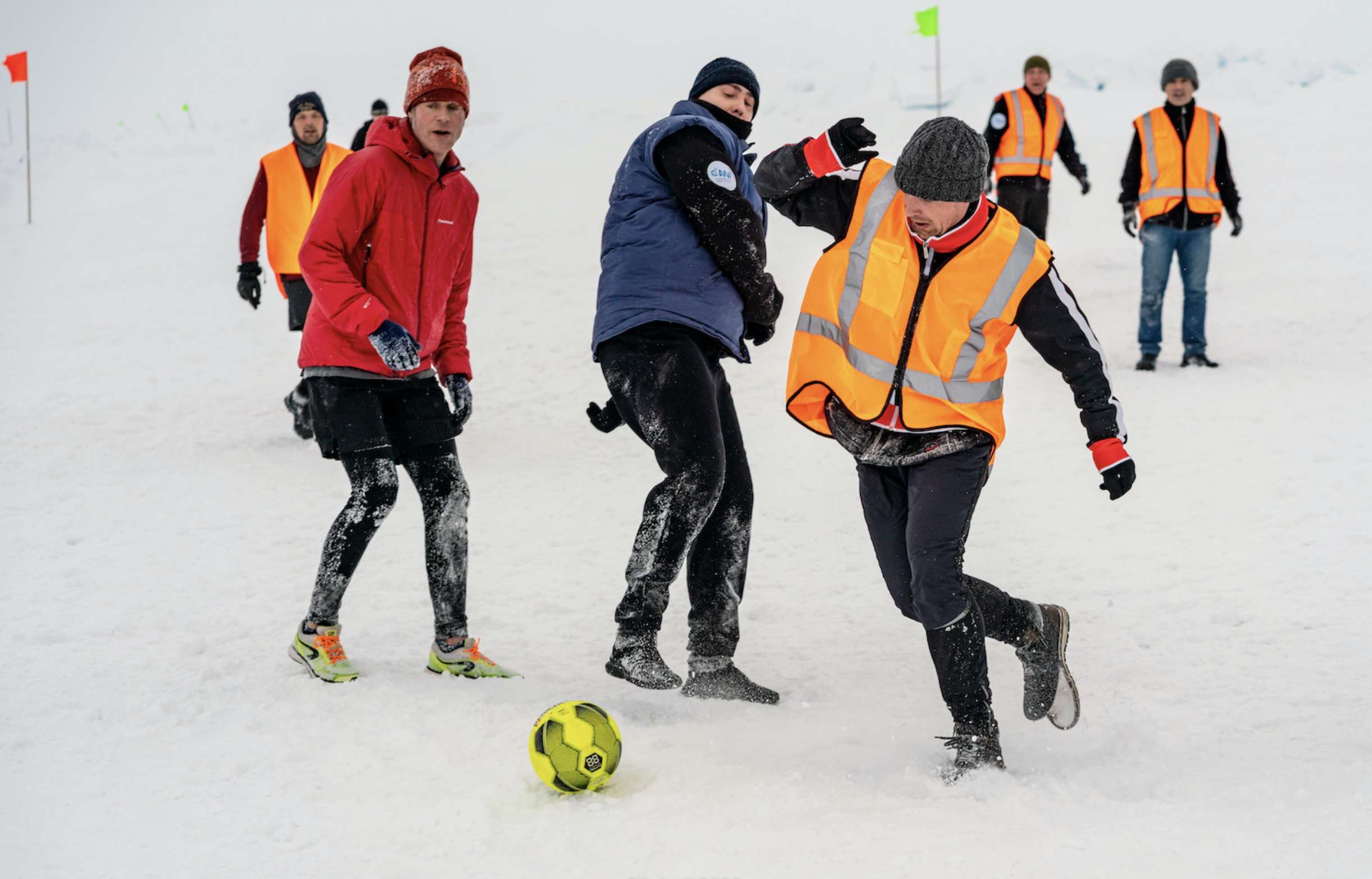Educators: Register now for MOSAiC expedition virtual teacher workshops this summer!
Bring the unprecedented science and adventure of the 2019-2020 MOSAiC expedition into your classroom with new middle and high school curricula developed by the education and outreach team at the University of Colorado Boulder. We are offering two different teacher workshops in June 2020, which will be facilitated virtually by MOSAiC scientists and the curriculum developers. Participants will engage with immersive 360° virtual expeditions, authentic real-time Arctic datasets, and App-based labs in these two-day online teacher workshops. Registration is free, and participants will earn 10 continuing education hours with the option of also receiving graduate credit from CU boulder.
Learn more about and register for the MOSAiC virtual workshops for teachers
How an Arctic Expedition is Weathering a Global Pandemic
"I never expected to come to the middle of the Arctic Ocean and have my daily life less restricted than it would (be) back home."
-Chris Marsay, Research Associate at the University of Georgia and MOSAiC Biogeochemistry team member. This quote is from an NPR news article written by Molly Samuel.
"What I thought would be surreal (working on a ship frozen into the ice in the middle of the Arctic Ocean) is now normal and the world that I left behind is the one that is surreal. I cannot imagine what it is like at home. Here we continue as normal on a ship. Social distancing is not a term in use. We can think of home but cannot imagine what it is really like.”
-Carin Ashjian, WHOI Biologist and MOSAiC Ecosystems team member. This quote is from a WHOI article written by Ken Kostel.
MOSAiC team members and crew are hard at work every day. But two evenings each week, they have leisure time where they can play games on the ice. Being in one of the most remote places on Earth as the coronavirus spread around the world has actually spared those on board the ship from having to implement social distancing practices like many of us in lower latitudes, but at the harsh cost of being far away from friends and family who are living in a much different reality. Photo credit: Christian Rohleder
NPR Article: There Is A Place With No Social Distancing And No Coronavirus
WHOI Article: Imagining Home: Scientist's stay in the Arctic extended by coronavirus
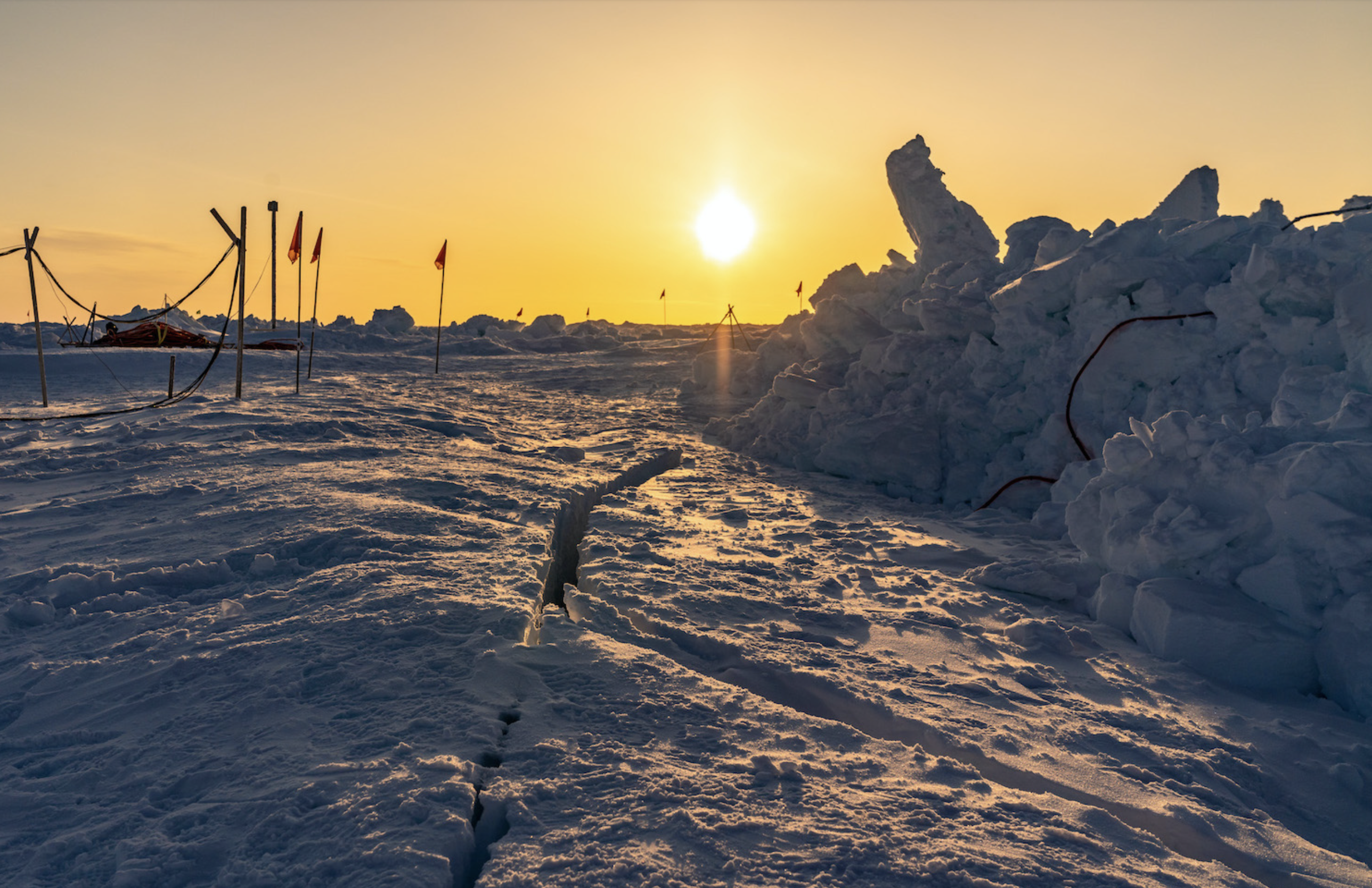
A Change in Course
The coronavirus spread has forced many people, organizations, and businesses to rethink how they will do things in the future. The MOSAiC expedition is no exception - team members currently on board the Polarstern who have been there since February were originally supposed to leave in April when a new set of participants would arrive via aircraft. But when travel restrictions were put in place to curtail the spread of the virus, an aircraft transfer was no longer possible, and a new plan was put in place.
In June, the Polarstern will leave its current location temporarily and sail out to meet up with another German resupply ship to swap out personnel. It will then travel back into the Arctic to continue drifting with the sea ice. This means MOSAiC team members and crew who have been on board the ship since February will be spending an unanticipated extra two months in the remote Arctic. This also means a there will be a short gap in data collection as many of the instruments on the ice will need to be packed up when the Polarstern leaves and redeployed when it returns to the ice. Out of caution, new crew members will spend time quarantined in Germany and will undergo testing before leaving on the resupply ship. Photo credit: Christian Rohleder
Read more: Coronavirus Interrupts, but Doesn't End, an Arctic Research Expedition
Going with the Floe
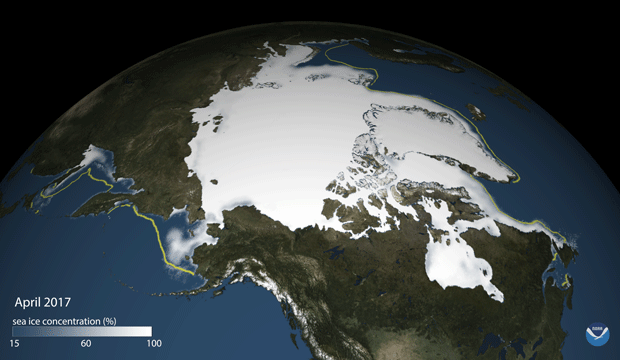
Will the Polarstern melt out of the sea ice too early?
In the Arctic Ocean, sea ice grows and shrinks with the seasons. From the beginning, the MOSAiC expedition was designed to take advantage of this, waiting until the sea ice extent was at its minimum in early Fall to drive the Polarstern in and anchor it to the ice. As winter approached and temperatures dropped, the sea ice would grow out around the ship so that it was encased within it. The idea was that the ship would drift across the Arctic with the sea ice for an entire year, melting out of its ice enclosure when sea ice was once again at a minimum. But the Polarstern has been drifting faster and farther than expected, and scientists think it's because the Arctic is changing. Arctic sea ice is becoming thinner, younger, and more seasonal. And this kind of ice drifts more quickly compared to older, thicker ice. Models are now predicting there is a chance the Polarstern could melt out of the ice well before the expedition is supposed to wrap up in October 2020.
Read more: Arctic Research Expedition Likely Faces Extreme Conditions in Fast-Changing Arctic
Video: Going With the Floe: Where will the MOSAiC expedition drift and will it melt out?
 Drift Comparison: Fram vs. Polarstern
Drift Comparison: Fram vs. Polarstern
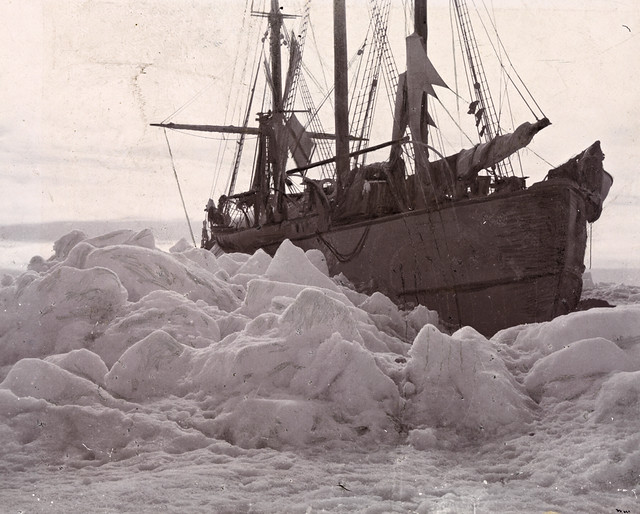
In October of 1893, Norwegian explorer Fridtjof Nansen's ship, the Fram, became trapped in sea ice in the Arctic and began its drift across the frozen ocean much like the Polarstern. Nansen and his crew were trying to see if there existed in the Arctic an east-west current that would carry them to the North Pole. The Polarstern has similarly been drifting with the Arctic sea ice since October, 2019. How far had the Fram traveled compared to the Polarstern over the same time period (~7 months)? Photo of the Fram in ice: National Library of Norway
Go to the MOSAiC Web App (https://follow.mosaic-expedition.org). You will see a map showing the route the Polarstern has traveled since it left Tromsø, Norway in September, 2019. Remember that the Polarstern anchored to its ice floe on October 4, 2019. If you scroll back through the daily expedition blog, you'll be able to see where the Polarstern was on that date, and thus about how far they have traveled. Click on the second ship icon in the lower left corner of the map to switch to the Fram view, and do the same thing - scroll back to when the Fram became trapped in ice on October 5, 1893. How have the drifts of the two ships compared over a similar time period? Have they traveled the same path across the Arctic? Have they drifted a similar distance, or has one drifted farther than the other?
 #askmosaic: A Dynamic Experience
#askmosaic: A Dynamic Experience
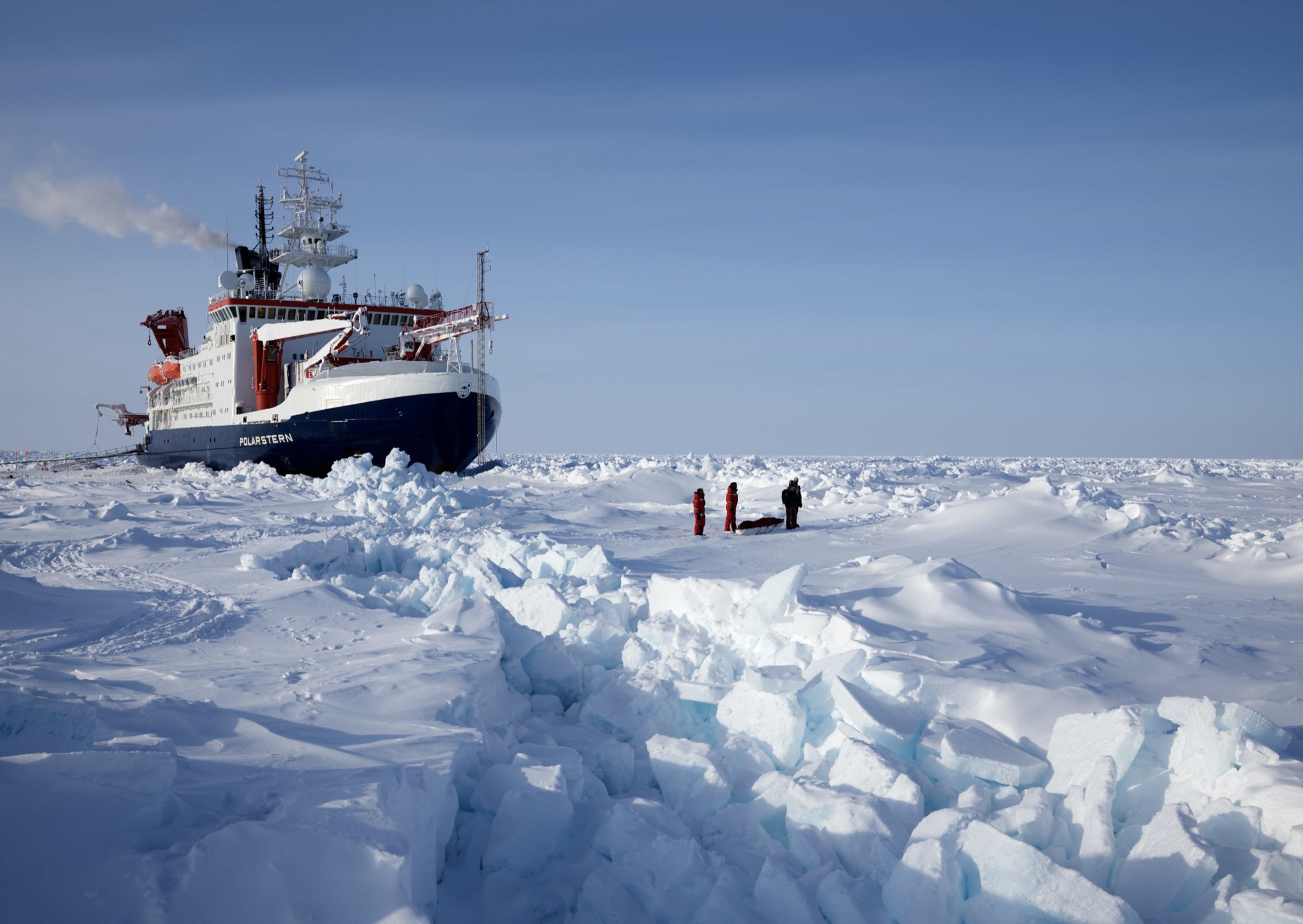
This question was submitted by Gracie from Middleton Middle School: What is the most interesting thing that you have experienced?
"The most interesting thing that I experienced on the third Leg of MOSAiC was definitely the ice dynamics, or just generally the ever-changing "icescape". Not only did it challenge us quite a lot in our everyday work of running our instruments and infrastructure, but it also demonstrates every single time that we're not operating on solid ground up here. Being able to watch the ice shear, tear apart and pile up several meters high is a spectacular demonstration of how wind and ocean currents have an influence on the ice through enormous forces acting upon it." Photo credit: Michael Gutsche
-Andi Preußer, MOSAiC Team Atmosphere
Submit your #askmosaic questions!
Fun At Home: Color the Polarstern!
Need a calming and fun activity to do while you're at home? We invite you to color the Polarstern! Artist Richard Yeomans created this drawing of the Polarstern for the Alfred Wegener Institute, and now we're giving it to you. Click on the picture to download and print a larger version. If you like, send us your completed masterpieces to be showcased in the Museum of MOSAiC Art!
Submit your artwork to the Museum of MOSAiC Art
 This week's featured remote learning resources
This week's featured remote learning resources
CIRES/NOAA Science-at-Home Speaker Series
The CIRES/NOAA Science-at-Home Virtual Speaker Series runs at 11am Tuesdays and 1pm Thursdays and is designed to show young students at home the work being done at CIRES and NOAA, and offer recommendations to activities that can be done at home to reinforce learning. All webinars have live closed-captioning available.
Learn more about and sign up for the Science-at-Home Speaker Series
Check out our full list of virtual and at-home polar learning resources here!
 MOSAiC Weekly Tracking
MOSAiC Weekly Tracking
Plot the Polarstern
Each week we will provide you with the latitude and longitude coordinates of the Polarstern so that you can track its journey across the Arctic.
Download the map to plot coordinates
Download a larger map of the Arctic for a bigger picture view of the expedition area
Location of the Polarstern
| Date | Latitude | Longitude |
| September 16, 2019 | 69.68 N | 18.99 E |
| September 23, 2019 | 72.31 N | 26.93 E |
| September 30, 2019 | 85.12 N | 138.05 E |
| October 4, 2019** | 85.08 N | 134.43 E |
| October 7, 2019 | 85.10 N | 133.82 E |
| October 14, 2019 | 84.85 N | 135.03 E |
| October 21, 2019 | 84.97 N | 132.73 E |
| October 28, 2019 | 85.47 N | 127.07 E |
| November 4, 2019 | 85.88 N | 121.70 E |
| November 11, 2019 | 85.82 N | 116.00 E |
| November 18, 2019 | 86.05 N | 122.43 E |
| November 25, 2019 | 85.85 N | 121.35 E |
| December 2, 2019 | 85.97 N | 112.95 E |
| December 9, 2019 | 86.25 N | 121.40 E |
| December 16, 2019 | 86.62 N | 118.12 E |
| December 23, 2019 | 86.63 N | 113.20 E |
| December 30, 2019 | 86.58 N | 117.13 E |
| January 6, 2020 | 87.10 N | 115.10 E |
| January 13, 2020 | 87.35 N | 106.63 E |
| January 20, 2020 | 87.42 N | 97.77 E |
| January 27, 2020 | 87.43 N | 95.82 E |
| February 3, 2020 | 87.42 N | 93.65 E |
| February 10, 2020 | 87.78 N | 91.52 E |
| February 17, 2020 | 88.07 N | 78.52 E |
| February 24, 2020 | 88.58 N | 52.87 E |
| March 2, 2020 | 88.17 N | 31.02 E |
| March 9, 2020 | 87.93 N | 24.20 E |
| March 16, 2020 | 86.87 N | 12.70 E |
| March 23, 2020 | 86.20 N | 15.78 E |
| March 30, 2020 | 85.37 N | 13.27 E |
| April 6, 2020 | 84.52 N | 14.38 E |
| April 13, 2020 | 84.28 N | 14.97 E |
| April 20, 2020 | 84.52 N | 14.57 E |
| April 27, 2020 | 83.93 N | 15.65 E |
| May 4, 2020 | 83.92 N | 18.03 E |
| May 11, 2020 | 83.47 N | 13.08 E |
**Day when MOSAiC reached the ice floe that the Polarstern will become frozen in and drift with for the next year.
Log MOSAiC Data
Keep track of Arctic conditions over the course of the expedition:
Download Data Logbook for Sept. 2019 - Dec. 2019
Download Data Logbook for Dec. 2019 - Mar. 2020
Download Data Logbook for Mar. 2020 - June 2020
| Date | Length of day (hrs) | Air temperature (deg C) at location of Polarstern | Arctic Sea Ice Extent (million km2) |
| September 16, 2019 | 13.25 | High: 10 Low: 4.4 | 3.9 |
| September 23, 2019 | 12.35 | High: 6 Low: -1 | 4.1 |
| September 30, 2019 | 9.1 | -4.7 | 4.4 |
| October 4, 2019** | 6.27 | -13.0 | 4.5 |
| October 7, 2019 | 3.05 | -8.2 | 4.6 |
| October 14, 2019 | 0 | -14.7 | 4.8 |
| October 21, 2019 | 0 | -12.8 | 5.4 |
| October 28, 2019 | 0 | -18.3 | 6.8 |
| November 4, 2019 | 0 | -18.9 | 8.0 |
| November 11, 2019 | 0 | -25.5 | 8.7 |
| November 18, 2019 | 0 | -10.7 | 9.3 |
| November 25, 2019 | 0 | -18.4 | 10.0 |
| December 2, 2019 | 0 | -26.6 | 10.4 |
| December 9, 2019 | 0 | -23.1 | 11.2 |
| December 16, 2019 | 0 | -19.2 | 11.8 |
| December 23, 2019 | 0 | -26.9 | 12.2 |
| December 30, 2019 | 0 | -26.4 | 12.6 |
| January 6, 2020 | 0 | -28.0 | 13.0 |
| January 13, 2020 | 0 | -30.7 | 13.1 |
| January 20, 2020 | 0 | -27.1 | 13.6 |
| January 27, 2020 | 0 | -22.5 | 13.8 |
| February 3, 2020 | 0 | -28.8 | 14.1 |
| February 10, 2020 | 0 | -26.2 | 14.5 |
| February 17, 2020 | 0 | -31.9 | 14.4 |
| February 24, 2020 | 0 | -24.0 | 14.6 |
| March 2, 2020 | 0 | -35.5 | 14.8 |
| March 9, 2020 | 0 | -37.9 | 14.7 |
| March 16, 2020 | 10.5 | -27.5 | 14.7 |
| March 23, 2020 | 16.5 | -28.7 | 14.4 |
| March 30, 2020 | 24 | -28.6 | 14.0 |
| April 6, 2020 | 24 | -18.2 | 13.7 |
| April 13, 2020 | 24 | -25.8 | 13.6 |
| April 20, 2020 | 24 | -10.2 | 13.3 |
| April 27, 2020 | 24 | -11.7 | 12.8 |
| May 4, 2020 | 24 | -16.2 | 12.8 |
| May 11, 2020 | 24 | -10.4 | 12.4 |
*Note: We expect data to fall within the following ranges: Length of day, 0-24 hours; Temperature, -40 to 14 degrees C; Sea ice extent, 3-15 million km2
**Day when MOSAiC reached the ice floe that the Polarstern will become frozen in and drift with for the next year.
Is there something you'd like to see in MOSAiC Monday? Let us know!
Send us your feedback
New to MOSAiC Monday? Check out past editions!
Browse more expedition-related educational resources, videos, and blogs
Email us! mosaic@colorado.edu

